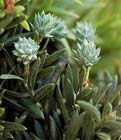Conservation Status

Saxegothaea conspicua
Lindley 1851
Common names
Mañio, mañiu, mañio de hojas cortas, mañio macho, mañio hembra [Spanish]; Prince Albert yew [hort. English] (Farjon 2010, Enciclopedia de la Flora Chilena [2013.03.26]).
Taxonomic notes
Syn. Squamataxus albertiana J. Nelson 1866. The sole species in Saxegothaea Lindl. 1851 (syn. Squamataxus J. Nelson 1866) (Farjon 1998). Gaussen (1976) placed Saxegothaea into a monotypic family Saxegothaeaceae, and Kelch (1997, 1998), using morphological and molecular (ribosomal DNA) data, found it sister to all other clades in the family (including Phyllocladus). Conversely, a molecular and morphological study of Podocarpaceae phylogeny done by Biffin et al. (2011) placed Saxegothaea alone in a clade intermediate amongst other Podocarp genera, with a divergence age (molecular clock) about 125 million years ago.
Description
Monoecious evergreen trees to 25 m tall and 200 cm dbh with one or multiple stems and long branches forming a rounded crown. Bark first brown, forming irregular exfoliating flakes. Foliage-bearing branches drooping; leaves spirally arranged but in shade foliage oriented in two divergent planes, short decurrent, linear or falcate with a mucronate tip, 15-25 × 2-3.5 mm; yellow to dark green with a thin midrib above; stomata in two continuous bands, on each side of the midrib, below; leaves retained about 4 years. Pollen cones axillary, usually solitary, 4-6 × 1.5 mm. Seed cones terminal, solitary, 9-12 mm diameter, comprised of 15-20 cone scales but appearing green ripening purple; the cone scales have a fleshy texture. Seeds 1 per scale, globose, 3 mm diameter. Flowers November-December; cones mature February-April (Lusk 2001, Hechenleitner et al. 2005, Farjon 2010). See García Esteban et al. (2004) for a detailed characterization of the wood anatomy.
Lindley (1851) put it this way: "Saxe-Gothaea may be described as a genus with the male flowers of a Podocarp, the females of a Dammar, the fruit of a Juniper, the seed of a Dacrydium, and the habit of a Yew."
Distribution and Ecology
S Chile (Aisén, Biobio, La Araucania, Los Lagos, and Maule) and S Argentina (Chubut, Neuquen, and Rio Negro) from 35° to 46° S latitude, at elevations of 0-1000 m (increasing with decreasing latitude) (Farjon 2010). Climate features a mean annual temperature of 8.7°C and a mean annual precipitation of 1690 mm (Biffin et al. 2011, Table S5). Hardy to Zone 8 (cold hardiness limit between -12.1°C and -6.7°C) (Bannister and Neuner 2001).
Found in Valdivian rain forest on slopes in the coastal mountains, or riparian in the Andes. Commonly grows as an extremely shade-tolerant understory shrub or tree, comparable to the northern species of Taxus (Farjon 2010); vegetative regeneration helps to maintain its presence as an understory tree, even in the absence of severe disturbance (Veblen et al. 1980, Lusk 1996). Typical associates, most of which are also evergreen, include Podocarpus nubigenus, Laureliopsis philippiana, Dasyphyllum diacnathoides, Embothrium coccineum, and various species of Nothofagus and Myrtaceae (Farjon 2010).
Although the species remains relatively widespread and represented by large subpopulations, it is threatened by conversion of habitat to plantation forest, often with exotic tree species. It is also exploited for timber and firewood. Fortunately it occurs in many areas that have already been protected as parks and reserves (Hechenleitner et al. 2005, Farjon 2010).
Remarkable Specimens
Lusk (1996) reports ages to 750 years, while Gutierrez et al. (2004) report ages in excess of 498 years.
Ethnobotany
Large, straight-grained individuals are cut for lumber, while others are cut for firewood. The species has become a popular ornamental in the U.K., where the climate is highly suitable. There are, as yet, no cultivars (Farjon 2010).Propagation of the species from seed requires cold stratification followed by a spring planting. Propagation from cuttings is feasible using rooting hormones (Hechenleitner et al. 2005).
Several dendrochronological studies have used this tree and have found that it can be crossdated. Both Lusk (1996) and Gutierrez et al. (2004) used it (and another conifer, Podocarpus nubigenus) to develop age structures in old forests of Chile and investigate questions about forest development, disturbance, and succession.
Observations
No data as of 2023.02.22.
Remarks
The genus is named for Prince Albert of Saxe-Coburg-Gotha (1819-1861), a patron of the sciences; the epithet means "remarkable" (Farjon 2010).
Citations
Gutierrez, A.G., Armesto, J.J., Aravena, J.C. 2004. Disturbance and regeneration dynamics of an old-growth North Patagonian rain forest in Chiloe Island, Chile. Journal of Ecology 92(4):598-608.
Hechenleitner V., P., M.F. Gardner, P.I. Thomas, C. Echeverría, B. Escobar, P. Brownless, and C. Martínez A. 2005. Plantas Amenazadas del Centro-Sur de Chile: Distribución, Conservación y Propagación. Valdivia. 188 pp.
Kelch, D.G. 1997. The phylogeny of the Podocarpaceae based on morphological evidence. Systematic Botany 22(1):113-131.
Kelch, D.G. 1998. Phylogeny of Podocarpaceae: comparison of evidence from morphology and 18S rDNA. American Journal of Botany 85(7):986-996.
Lindley. 1851. Notices of certain Ornamental Plants lately introduced into England. Journal of the Horticultural Society of London v. 6, p. 258. Available: Biodiversity Heritage Library, accessed 2023.01.07.
Lusk, C.H. 1996. Stand dynamics of the shade-tolerant conifers Podocarpus nubigena and Saxogothaea conspicua in Chilean temperate rain forest. Journal of Vegetation Science 7(4):549-558.
Lusk, C.H. 2001. Leaf life spans of some conifers of the temperate forests of South America. Revista Chilena de Historia Natural 74:711–718.
Veblen, T.T., F.M. Schlegel, and B. Escobar R. 1980. Structure and dynamics of old-growth Nothofagus forests in the Valdivian Andes, Chile. Journal of Ecology 68:1–31.
See also
Elwes and Henry 1906-1913 at the Biodiversity Heritage Library. This series of volumes, privately printed, provides some of the most engaging descriptions of conifers ever published. Although they only treat species cultivated in the U.K. and Ireland, and the taxonomy is a bit dated, still these accounts are thorough, treating such topics as species description, range, varieties, exceptionally old or tall specimens, remarkable trees, and cultivation. Despite being over a century old, they are generally accurate, and are illustrated with some remarkable photographs and lithographs.






